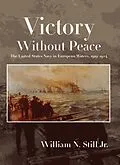Victory Without Peace is about the US Navy in European and Near Eastern waters in the post World War I era. It is the third book in the author's study of the US Navy in European waters. The author discusses the Navy's participation in the peace negotiations at Versailles. The Navy was involved carrying out the naval terms of the Armistice and peace negotiations and in efforts to preserve stability and peace created by the war, revolutions, civil wars, famine and general unrest. US warships were deployed in the Near East, the Baltic, northern Europe, and the Adriatic at the same time that demobilization was withdrawing these forces from European waters. The United States Navy for the first time contributed to these peacetime efforts. It set a precedence that the Navy still carried out today. This deployment was handicapped by demobilization, general naval policy and the postwar reduction of personnel and operating funds as a result of Congressional appropriations. The Navy was reluctant to allocate forces to European and Near Eastern waters considered after the war to be of little importance to the United States. Nonetheless, under pressure from the State Department and Herbert Hoover, as head of the American Relief Administration, forces were deployed and played significant roles in carrying out their responsibilities. Most of them were withdrawn by 1924 and the European Station assumed the traditional policy of showing the flag.
Autorentext
William N. Still served in the U.S Navy and was director of the maritime studies program at East Carolina University. He has published several naval history books, including the award winning Crisis at Sea: The United States in European Waters in World War One. He also served as the Secretary of the Navy's scholar in naval history at the Naval History and Heritage Command. He is now retired.
Klappentext
Victory Without Peace concentrates on the U.S. Navy in European and Near Eastern waters during the post-World War I era. As participants in the Versailles peace negotiations, the Navy was charged with executing the naval terms of the Armistice as well as preserving stability and peace. U.S. warships were deploying into the Near East, Baltic, Adriatic, and Northern Europe, while simultaneously withdrawing its demobilized forces from European waters. This signifies the first time the U.S. Navy contributed to peacetime efforts, setting a precedent continues today. Conversely, Congressional appropriations handicapped this deployment by demobilization, general naval policy and postwar personnel, and operating funds reductions. Though reluctant to allocate postwar assets into seemingly unimportant European and Near Eastern waters, the Navy was pressured by the State Department and the American Relief Administration's leader, Herbert Hoover, to deploy necessary forces. Most of these were withdrawn by 1924 and the European Station assumed the traditional policy of showing the flag.
Titel
Victory Without Peace
Untertitel
The United States Navy in European Waters, 1919-1924
Autor
EAN
9781682470152
ISBN
978-1-68247-015-2
Format
E-Book (epub)
Hersteller
Herausgeber
Genre
Veröffentlichung
15.01.2017
Digitaler Kopierschutz
Adobe-DRM
Dateigrösse
4.76 MB
Anzahl Seiten
392
Jahr
2017
Untertitel
Englisch
Unerwartete Verzögerung
Ups, ein Fehler ist aufgetreten. Bitte versuchen Sie es später noch einmal.
